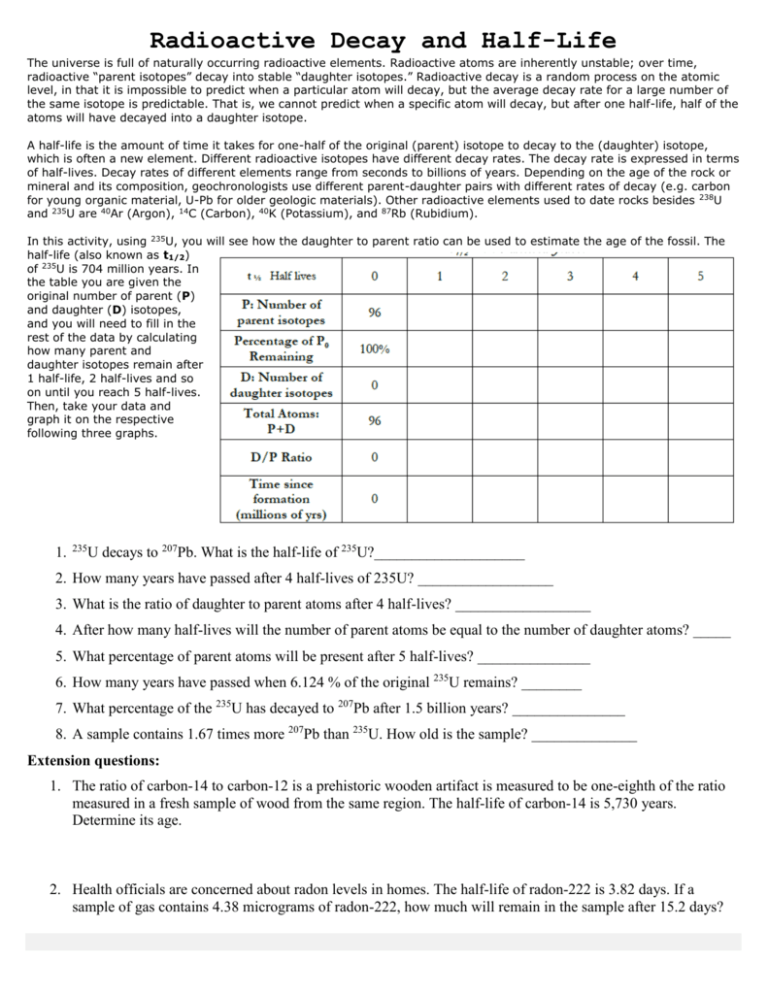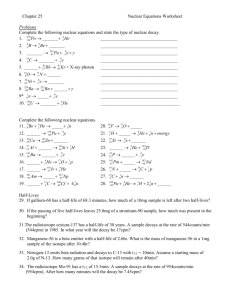Radioactive Decay and Half
advertisement

Radioactive Decay and Half-Life The universe is full of naturally occurring radioactive elements. Radioactive atoms are inherently unstable; over time, radioactive “parent isotopes” decay into stable “daughter isotopes.” Radioactive decay is a random process on the atomic level, in that it is impossible to predict when a particular atom will decay, but the average decay rate for a large number of the same isotope is predictable. That is, we cannot predict when a specific atom will decay, but after one half-life, half of the atoms will have decayed into a daughter isotope. A half-life is the amount of time it takes for one-half of the original (parent) isotope to decay to the (daughter) isotope, which is often a new element. Different radioactive isotopes have different decay rates. The decay rate is expressed in terms of half-lives. Decay rates of different elements range from seconds to billions of years. Depending on the age of the rock or mineral and its composition, geochronologists use different parent-daughter pairs with different rates of decay (e.g. carbon for young organic material, U-Pb for older geologic materials). Other radioactive elements used to date rocks besides 238U and 235U are 40Ar (Argon), 14C (Carbon), 40K (Potassium), and 87Rb (Rubidium). In this activity, using 235U, you will see how the daughter to parent ratio can be used to estimate the age of the fossil. The half-life (also known as t1/2) of 235U is 704 million years. In the table you are given the original number of parent (P) and daughter (D) isotopes, and you will need to fill in the rest of the data by calculating how many parent and daughter isotopes remain after 1 half-life, 2 half-lives and so on until you reach 5 half-lives. Then, take your data and graph it on the respective following three graphs. 1. 235 U decays to 207Pb. What is the half-life of 235U?____________________ 2. How many years have passed after 4 half-lives of 235U? __________________ 3. What is the ratio of daughter to parent atoms after 4 half-lives? __________________ 4. After how many half-lives will the number of parent atoms be equal to the number of daughter atoms? _____ 5. What percentage of parent atoms will be present after 5 half-lives? _______________ 6. How many years have passed when 6.124 % of the original 235U remains? ________ 7. What percentage of the 235U has decayed to 207Pb after 1.5 billion years? _______________ 8. A sample contains 1.67 times more 207Pb than 235U. How old is the sample? ______________ Extension questions: 1. The ratio of carbon-14 to carbon-12 is a prehistoric wooden artifact is measured to be one-eighth of the ratio measured in a fresh sample of wood from the same region. The half-life of carbon-14 is 5,730 years. Determine its age. 2. Health officials are concerned about radon levels in homes. The half-life of radon-222 is 3.82 days. If a sample of gas contains 4.38 micrograms of radon-222, how much will remain in the sample after 15.2 days? Radioactive Decay and Half-Life The universe is full of naturally occurring radioactive elements. Radioactive atoms are inherently unstable; over time, radioactive “parent isotopes” decay into stable “daughter isotopes.” Radioactive decay is a random process on the atomic level, in that it is impossible to predict when a particular atom will decay, but the average decay rate for a large number of the same isotope is predictable. That is, we cannot predict when a specific atom will decay, but after one half-life, half of the atoms will have decayed into a daughter isotope. A half-life is the amount of time it takes for one-half of the original (parent) isotope to decay to the (daughter) isotope, which is often a new element. Different radioactive isotopes have different decay rates. The decay rate is expressed in terms of half-lives. Decay rates of different elements range from seconds to billions of years. Depending on the age of the rock or mineral and its composition, geochronologists use different parent-daughter pairs with different rates of decay (e.g. carbon for young organic material, U-Pb for older geologic materials). Other radioactive elements used to date rocks besides 238U and 235U are 40Ar (Argon), 14C (Carbon), 40K (Potassium), and 87Rb (Rubidium). In this activity, using 235U, you will see how the daughter to parent ratio can be used to estimate the age of the fossil. The half-life (also known as t1/2) of 235U is 704 million years. In the table you are given the original number of parent (P) and daughter (D) isotopes, 128 and you will need to fill in the rest of the data by calculating how many parent and daughter isotopes remain after 1 half-life, 2 half-lives and so on until you reach 5 half-lives. Then, take your data and graph it on the respective 128 following three graphs. 9. 235 U decays to 207Pb. What is the half-life of 235U?____________________ 10. How many years have passed after 4 half-lives of 235U? __________________ 11. What is the ratio of daughter to parent atoms after 4 half-lives? __________________ 12. After how many half-lives will the number of parent atoms be equal to the number of daughter atoms? _____ 13. What percentage of parent atoms will be present after 5 half-lives? _______________ 14. How many years have passed when 6.124 % of the original 235U remains? ________ 15. What percentage of the 235U has decayed to 207Pb after 1.5 billion years? _______________ 16. A sample contains 1.67 times more 207Pb than 235U. How old is the sample? ______________ Extension questions: 3. The ratio of carbon-14 to carbon-12 is a prehistoric wooden artifact is measured to be one-eighth of the ratio measured in a fresh sample of wood from the same region. The half-life of carbon-14 is 5,730 years. Determine its age. 4. Health officials are concerned about radon levels in homes. The half-life of radon-222 is 3.82 days. If a sample of gas contains 4.38 micrograms of radon-222, how much will remain in the sample after 15.2 days?









